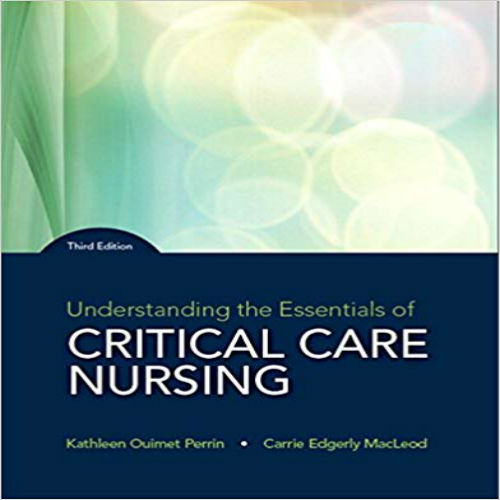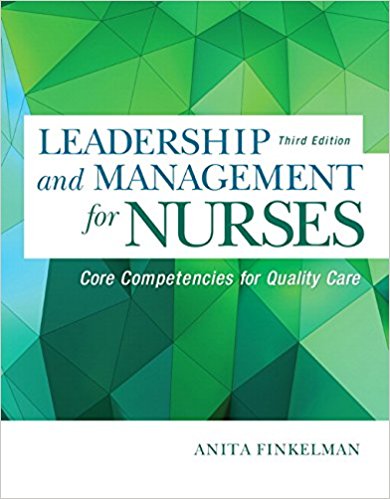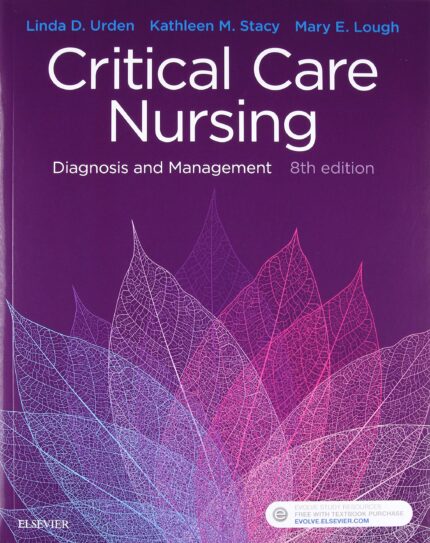Understanding the Essentials of Critical Care Nursing, 3e (Perrin)
Understanding the Essentials of Critical Care Nursing 3rd Edition – Test bank
Understanding the Essentials of Critical Care Nursing
Chapter 1 What Is Critical Care?
1) The nurse reviews assessment data on a group of patients. Which patient should the nurse identify as experiencing a critical illness?
- Chronic airflow limitation with VS: BP 110/72, P 110, R 16
- Acute bronchospasm with VS: BP 100/60, P 124, R 32
- Motor vehicle crash with VS: BP 124/74, P 74, R 18
- Chronic renal failure on hemodialysis with no urine output with VS: BP 98/50, P 108, R 12
Answer: 2
Explanation: 1. The blood pressure and respiratory rate are considered within normal limits. The heart rate is slightly elevated. Based upon these vital signs, this patient is not critically ill.
- Acute bronchospasm can present a life-threatening situation, which can jeopardize a patient’s survival. The patient’s pulse and respiratory rate are elevated, which could indicate a critical illness.
- According to the vital signs, this patient is not critically ill despite being in a motor vehicle crash.
- The patient receiving hemodialysis for chronic renal failure is not considered critically ill unless another disease process or health issue develops. The patient’s vital signs are consistent with someone with chronic renal failure.
Cognitive Level: Analyzing
Client Need: Physiological Integrity
Client Need Sub: Physiological Adaptation
Nurs./Integ. Concepts: Nursing Process: Assessment
Learning Outcome: 1-1: Analyze the key components of safe, effective care in the critical care environment.
2) Which patient should the nurse expect to be transferred to a critical care unit? Select all that apply.
Note: Credit will be given only if all correct choices and no incorrect choices are selected.
- Experiences an acetaminophen overdose
- Diagnosed with an acute mental illness
- Receiving treatment for chronic renal failure
- New onset of acute decompensated heart failure
- Treatment for bacteremia from an infected foot wound
Answer: 1, 4, 5
Explanation: 1. Critical care units are cost-efficient units for caring for patients with specific organ system failure. Patients with acetaminophen overdose often suffer liver failure as a consequence.
- A patient with acute mental illness would not receive care in a critical care unit. This health problem would be considered noncritical.
- Even though critical care units are cost-efficient units for caring for patients with specific organ system failure, chronic renal failure is not a disease process necessitating the critical care environment.
- The patient with acute decompensated heart failure would receive care in a critical care unit. This patient has a specific organ that has failed.
- Bacteremia can affect many organs and can lead to multisystem organ failure. This patient would receive care in a critical care unit.
Cognitive Level: Analyzing
Client Need: Physiological Integrity
Client Need Sub: Physiological Adaptation
Nurs./Integ. Concepts: Nursing Process: Assessment
Learning Outcome: 1-1: Analyze the key components of safe, effective care in the critical care environment.
3) The nurse employed in a hospital in a small rural town would expect to provide which level of care in the critical care unit?
- Level I
- Level II
- Level III
- It is unlikely that the hospital would have a critical care unit.
Answer: 3
Explanation: 1. This level of care is most likely provided within teaching hospitals and not in a rural facility.
- This level is able to provide comprehensive critical care for most disorders, but the unit may not be able to care for specific types of patients. It is unlikely that this level of care would be available in a small rural facility.
- Level III facilities provide initial stabilization of critically ill patients but limited ability to provide comprehensive critical care. A limited number of patients who require routine care may remain in the facility, but written policies should be in place determining which patients require transfer and where they ought to be transferred. This level of care is most likely provided in a small rural facility.
- Most hospitals have some level of critical care area.
Cognitive Level: Applying
Client Need: Safe, Effective Care Environment
Client Need Sub: Management of Care
Nurs./Integ. Concepts: Nursing Process: Planning
Learning Outcome: 1-1: Analyze the key components of safe, effective care in the critical care environment.
4) With which individuals should the nurse expect to provide patient care in an “open” ICU?
- Multidisciplinary team with physicians who are also responsible for patients on other units
- Multidisciplinary team that includes a physician employed by the hospital
- Physician in charge of patient care who is a specialist in critical care
- Primary care physician who must consult a critical care specialist
Answer: 1
Explanation: 1. In an open ICU, nurses, pharmacists, and respiratory therapists are ICU based, but the physicians directing patient care may have other obligations. These physicians may or may not choose to consult an intensivist to assist with the management of their ICU patients.
- This does not describe an open ICU.
- This does not describe an open ICU.
- This does not describe an open ICU.
Cognitive Level: Analyzing
Client Need: Safe, Effective Care Environment
Client Need Sub: Management of Care
Nurs./Integ. Concepts: Nursing Process: Planning
Learning Outcome: 1-3: Examine the multidisciplinary nature of care within the critical care environment.
Table of Contents
| Table of Contents
1. What is Critical Care? 2. Care of the Critical Ill Patient 3. Care of the Patient with Respiratory Failure 4. Interpretation and Management of Basic Dysrhythmias 5. Cardiodynamics and Hemodynamic Regulation 6. Care of the Patient Experiencing Shock 7. Care of the Patient Experiencing Heart Failure 8. Care of the Patient Experiencing Acute Coronary Syndrome 9. Care of the Patient Following Traumatic Injury 10. Care of the Patient Experiencing an Intracranial Dysfunction 11. Care of the Patient With a Cerebral or Cerebrovascular Disorder 12. Care of the Critically Ill Patient Experiencing Alcohol Withdrawal and/or Liver Failure 13. Care of the Patient With an Acute Gastrointestinal Bleed or Pancreatitis 14. Care of the Patient with Problems in Glucose Metabolism 15. Care of the Patient with Acute Kidney Injury 16. Care of the Organ Donor and Transplant Recipient 17. Care of the Acutely Ill Burn Patient 18. Care of the Patient with Sepsis 19. Care of the ICU Patient at the End of Life |












